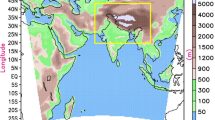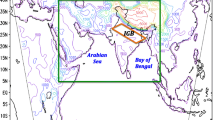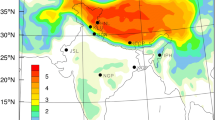Abstract
A large uncertainty exists today in quantifying the absorbing aerosol snow darkening effect (SnoDE) and its relative role compared to the direct radiative effect (DRE), especially at the regional scale. Using a regional climate model over an enlarged South Asia Coordinated Regional Climate Downscaling Experiment (CORDEX) domain, here we isolate these effects and examine their impacts on the dynamics of the Indian pre-monsoon and summer monsoon (ISM) circulation. Our results clearly indicate that the regional dynamics associated with the pre-monsoon and ISM are highly sensitive to both aerosol SnoDE and DRE, with the SnoDE dominating during the pre-monsoon, and the DRE during the ISM. During the pre-monsoon, the deposition of aerosols on the Himalayas and Tibetan Plateau (HTP) reduces the surface albedo, leading to an increase in absorption of solar radiation and accelerated snow melting. The associated increase in surface and tropospheric temperature draws dry air from central Asia towards northern India and along the Himalayan foothills, creating a low-level anti-cyclonic anomaly over eastern India and the Bay of Bengal. This limits the northward propagation of southwest winds and leads to a decrease in precipitation over the central and eastern parts of India during the pre-monsoon and across northern India in the following ISM. Conversely, an increase in precipitation during the ISM is due to the strengthening of southwest winds caused by large-scale convergence over the Arabian Peninsula. The shift of winds from central Asia towards northern India in the SnoDE and towards the Arabian Peninsula in DRE leads to contrasting effects and can possibly modulate the monsoon onset dates. The SnoDE, with a prevailing contribution from dust, leads to an increase in precipitation over the HTP, which is amplified during the ISM when DRE is also considered. Our study provides evidence that both these aerosol effects have substantial impacts on the pre-monsoon and ISM dynamics and hence need to be considered in climate model simulations over the region.















Similar content being viewed by others
References
Adam JS, Lettenmaier DP (2003) Adjustment of global gridded precipitation for systematic bias. J Geophys Res Atmos 108:4957. https://doi.org/10.1029/2002JD002499
Albrecht BA (1989) Aerosols, cloud microphysics, and fractional cloudiness. Science 245:1227–1230. https://doi.org/10.1126/science.245.4923.1227
Bollasina MA, Ming Y, Ramaswamy V (2011) Anthropogenic aerosols and the weakening of the south Asian summer monsoon. Science 334:502–506
Dai L, Che T, Ding Y, Hao X (2017) Evaluation of snow cover and snow depth on the Qinghai–Tibetan Plateau derived from passive microwave remote sensing, The Cryosphere. 1933–1948
Das S, Dey S, Dash SK, Giuliani G, Solmon F (2015) Dust aerosol feedback on the Indian summer monsoon: Sensitivity to absorption property. J Geophys Res 120(18):9642–9652
Das S, Giorgi F, Giuliani G, Dey S, Coppola E (2020) Near-future anthropogenic aerosol emission scenarios and their direct radiative effects on the present-day characteristics of the Indian summer monsoon. J Geophys Res Atmos. https://doi.org/10.1029/2019JD031414
Dang C, Fu Q, Warren SG (2016) Effect of snow grain shape on snow albedo. J Atmos Sci 73:3573–3583. https://doi.org/10.1175/JAS-D-15-0276.1
Dee DP, Uppala SM, Simmons AJ et al (2011) The ERA-interim reanalysis: configuration and performance of the data assimilation system. Q J R Meteorol Soc 137:553–597
Dey S, Girolamo LD (2010) A climatology of aerosol optical and microphysical properties over the Indian subcontinent from 9 years (2000–2008) of Multiangle Imaging Spectroradiometer (MISR) data. J Geophys Res 115(D15):D15204. https://doi.org/10.1029/2009JD013395
Diner DJ et al (1998) Multiangle Imaging SpectroRadiometer (MISR) instrument description and experiment overview. IEEE Trans Geosci Remote Sens 36:1072–1087
Di Sante F, Coppola E, Farneti R, Giorgi F (2019) Indian Summer Monsoon as simulated by the regional earth system model RegCM-ES: the role of local air–sea interaction. Clim Dyn 53:759–778. https://doi.org/10.1007/s00382-019-04612-8
Emanuel K, Zivkovic-Rothman M (2000) Comments on “development and evaluation of a convection scheme for use in climate models”. J Atmos Sci 57:3686–3686
Flanner MG, Zender CS, Randerson JT, Rasch PJ (2007) Present-day climate forcing and response from black carbon in snow. J Geophys Res 112:1–17. https://doi.org/10.1029/2006JD008003
Flanner MG, Zender CS, Hess PG, et al (2009) and Physics Springtime warming and reduced snow cover from carbonaceous particles. Atmos Chem Phys 2481–2497
Giorgi F, Marinucci MR, Bates GT, Canio GD (1993) Development of a second-generation regional climate model (RegCM2). Part II: convective processes and assimilation of lateral boundary conditions. Mon Wea Rev 121:2814–2832
Giorgi F, Bi X, Qian Y (2002) Direct radiative forcing and regional climatic effects of anthropogenic aerosols over East Asia: a regional coupled climate-chemistry/aerosol model study. J Geophys Res. https://doi.org/10.1029/2001JDOO1066
Giorgi F, Jones C, Asrar GR (2009) Addressing climate information needs at the regional level: the CORDEX framework. WMO Bull 58.
Giorgi F, Coppola E, Solmon F et al (2012) RegCM4: model description and preliminary tests over multiple CORDEX domains. Clim Res. https://doi.org/10.3354/cr01018
Giorgi F (2019) Thirty years of regional climate modeling: where are we and where are we going next? J Geophys Res 124:5696–5723. https://doi.org/10.1029/2018JD030094
Grenier H, Bretherton CS (2001) A moist PBL parameterization for large-scale models and its application to subtropical cloud-topped marine boundary layers. Mon Weather Rev 129:357–377. https://doi.org/10.1175/1520-0493(2001)129%3c0357:AMPPFL%3e2.0.CO;2
Ganguly D, Rasch PJ, Wang H, Yoon J (2012) Fast and slow responses of the South Asian monsoon system to anthropogenic aerosols. Geophys Res Lett 39:L18804. https://doi.org/10.1029/2012GL053043
Gautam R, Hsu NC, Lau WK, Yasunari TJ (2013) Satellite observations of desert dust-induced Himalayan snow darkening. Geophys Res Lett 40:988–993. https://doi.org/10.1002/GRL.50226
Habib G, Venkataraman C, Chiapello I, Ramachandran S, Boucher O, Reddy M (2006) S (2006) Seasonal and inter-annual variability in absorbing aerosols over India derived TOMS: relationship to regional meteorology and emissions. Atmos Environ 40:1909–1921
Hall, D. K., Riggs GA, and Salomonson. VV (2006). MODIS/Terra Snow Cover 5-Min L2 Swath 500m. Version 5. Boulder, Colorado USA: NASA National Snow and Ice Data Center Distributed Active Archive Center. https://doi.org/10.5067/ACYTYZB9BEOS
Haywood J, Boucher O (2000) Estimates of the direct and indirect radiative forcing due to tropospheric aerosols: a review. Rev Geophy 513–543
He C, Liou KN, Takano Y, Zhang R, Levy Zamora M, Yang P, Li Q, Leung LR (2015) Variation of the radiative properties during black carbon aging: theoretical and experimental intercomparison. Atmos Chem Phys 15:11967–11980. https://doi.org/10.5194/acp-15-11967-2015
He C, Takano Y, Liou K, Yang P, Li Q, Chen F (2017) Impact of snow grain shape and black carbon-snow internal mixing on snow optical properties: parameterizations for climate models. J Clim 30:10019–10036. https://doi.org/10.1175/JCLI-D-17-0300.1
He C, Flanner MG, Chen F et al (2018) Black carbon-induced snow albedo reduction over the Tibetan Plateau : uncertainties from snow grain shape and aerosol—snow mixing state based on an updated SNICAR model. Atmos Chem Phys 11507–11527
Huffman GJ, Adler RF, Bolvin DT, Hsu K, Kidd C, Nelkin EJ, Tan J, Xie P (2019) Algorithm theoretical basis document (ATBD) for global precipitation climatology project version 3.0 precipitation data. MEaSUREs project, Greenbelt, p 26
Kahn RA, Gaitley BJ (2015JD) An analysis of global aerosol type as retrieved by MISR. J Geophys Res Atmos 120:4248–4281. https://doi.org/10.1002/2015JD023322
Jacobson M (2001) Strong radiative heating due to the mixing state of black carbon in atmospheric aerosols. Nature 409:695–697
Jin Q, Wei J, Yang ZL, Pu B, Huang J (2015) Consistent response of Indian summer monsoon to Middle East dust in observations and simulations. Atmos Chem and Phys. https://doi.org/10.5194/acpd-15-15571-2015
Kalnay E et al (1996) The NCEP/NCAR 40-year reanalysis project. Bull Am Meteorol Soc 77(93):437–471
Kiehl JT, Hack JJ, Bonan GB, Boville BA, Briegleb BP, Williamson D, Rasch P (1996) Description of the NCAR community climate model (CCM3), Tech. Rep. National Center for Atmospheric Research, NCAR/TN-420+STR
Lau WKM, Kim KM (2006) Observational relationships between aerosol and Asian monsoon rainfall, and circulation. Geophys Res Lett 33(21):L21810. https://doi.org/10.1029/2006GL027546
Lau WKM, Kim MK, Kim KM (2006) Asian summer monsoon anomalies induced by aerosol direct forcing: the role of the Tibetan Plateau. Clim Dyn 26(7–8):855–864. https://doi.org/10.1007/s00382-006-0114-z
Lau WKM, Kim MK, Kim KM, Lee WS (2010) Enhanced surface warming and accelerated snowmelt in the Himalayas and Tibetan Plateau induced by absorbing aerosols. Environ Res Lett 5:025204
Lau WKM, Kim KM (2018) Impact of snow darkening by deposition of light-absorbing aerosols on snow cover in the himalayas—Tibetan Plateau and influence on the Asian summer monsoon : a possible mechanism for the Blanford hypothesis. Atmosphere : https://doi.org/10.3390/atmos9110438
Lau WKM, Sang J, Kim MK, Kim KM, Koster RD, Yasunari TJ (2018) Impacts of snow darkening by deposition of light-absorbing aerosols on hydroclimate of Eurasia during boreal spring and summer. J Geophys Res. https://doi.org/10.1029/2018JD028557
Lee W, Liou KN, He C, Liang HC, Wang TC, Li Q, Liu Z, Yue Q (2017) Impact of absorbing aerosol deposition on snow albedo reduction over the southern Tibetan plateau based on satellite observations. Theor Appl Climatol 129:1373–1382. https://doi.org/10.1007/s00704-016-1860-4
Liou KN, Takano Y, He C, Yang P, Leung LR, Gu Y, Lee WL (2014) Stochastic parameterization for light absorption by internally mixed BC/dustin snow grains for application to climate models. J Geophys Res Atmos 119:7616–7632. https://doi.org/10.1002/2014JD021665
Liu D, Whitehead J, Alfarra M et al (2017) Black-carbon absorption enhancement in the atmosphere determined by particle mixing state. Nature Geosci 10:184–188. https://doi.org/10.1038/ngeo2901
Manoj MG, Devara PCS, Safai PD, Goswami BN (2011) Absorbing aerosols facilitate transition of Indian monsoon breaks to active spells. Clim Dyn 37(11–12):2181–2198
Menon S, Hansen J, Nazarenko L (2002) Climate effects of black carbon aerosols in China and India. Science 297:2250–2253. https://doi.org/10.1126/science.1075159
Meehl G, Arblaster JM, Collins WD (2008) Effects of black carbon aerosols on the Indian monsoon. J Clim 21(12):2869–2882. https://doi.org/10.1175/2007JCLI1777.1
Ming J, Wang P, Zhao S, Chen P (2013) Disturbance of light-absorbing aerosols on the albedo in a winter snow-pack of Central Tibet. J Environ Sci 25:1601–1607
Nigam S, Bollasina M (2010) “Elevated heat pump” hypothesis for the aerosol-monsoon hydroclimate link: “Grounded” in observations? J Geophys Res 115(D16):D16201. https://doi.org/10.1029/2009JD013800
Oleson KW, Lawrence DM, Gordon B, et al (2013) Technical description of version 4.5 of the Community Land Model (CLM). NCAR/TN-503+STR NCAR Tech Note 266.
Pal JS, Small EE, Eltahir EAB (2000) Simulation of regional-scale water and energy budgets: Representation of subgrid cloud and precipitation processes within RegCM. J Geophys Res Atmos 105(D24):29579–29594. https://doi.org/10.1029/2000JD900415
Qian Y, Flanner MG, Leung LR, Wang W (2011) Sensitivity studies on the impacts of Tibetan Plateau snowpack pollution on the Asian hydrological cycleand monsoon climate. Atmos Chem Phys 11:1929–1948. https://doi.org/10.5194/acp-11-1929-2011
Rahimi S, Liu X, Wu C, Lau WK, Brown H, Wu M, Qian Y (2019) Quantifying snow darkening and atmospheric radiative effects of black carbon and dust on the South Asian monsoon and hydrological cycle: experiments using variable-resolution CESM. Atmos Chem Phys 19:12025–12049. https://doi.org/10.5194/acp-19-12025-2019
Raju PVS, Bhatla R, Almazroui M, Assiri M (2015) Performance of convection schemes on the simulation of summer monsoon features over the South Asia CORDEX domain using RegCM-4.3. Int J Climatol 35:4695–4706. https://doi.org/10.1002/joc.4317
Ramanathan V, Chung C, Kim D et al (2005) Atmospheric brown clouds: impacts on South Asian climate and hydrological cycle. Proc Natl Acad Sci USA 102:5326–5333
Sarangi C, Qian Y, Rittger K, Bormann KJ, Liu Y, Wang H, Wan H, Lin G, Painter TH (2019) Impact of light-absorbing particles on snow albedo darkening and associated radiative forcing over high-mountain Asia: high-resolution WRF-Chem modeling and new satellite observations. Atmos. Chem. Phys. 19:7105–7128. https://doi.org/10.5194/acp-19-7105-2019
Sengupta K, Dey S, Sarkar M (2013) Structural evolution of monsoon clouds in the Indian CTCZ. Geophys Res Lett 40:5295–5299. https://doi.org/10.1002/grl.50970
Sinha P, Mohanty UC, Kar SC et al (2013) Sensitivity of the GCM driven summer monsoon simulations to cumulus parameterization schemes in nested RegCM3. Theor Appl Climatol 112:285–306. https://doi.org/10.1007/s00704-012-0728-5
Shi Y, Zhang J, Reid JS, Liu B, Hyer EJ (2014) Critical evaluation of cloud contamination in the MISR aerosol products using MODIS cloud mask products. Atmos Meas Tech 7:1791–1801. https://doi.org/10.5194/amt-7-1791-2014
Shi Z, Xie X, Li X et al (2019) Snow-darkening versus direct radiative effects of mineral dust aerosol on the Indian summer monsoon onset : role of temperature change over dust sources. Atmos Chem Phys 605–1622
Solmon F, Giorgi F, Liousse C (2006) Aerosol modelling for regional climate studies: application to anthropogenic particles and evaluation over a European/African domain. Tellus B 58:51–72. https://doi.org/10.1111/j.1600-0889.2005.00155.x
Solmon F, Nair VS, Mallet M (2015) Increasing Arabian dust activity and the Indian summer monsoon. Atmos Chem Phys. https://doi.org/10.5194/acp-15-8051-2015
Srivastava AK, Tiwari S, Devara PCS, Bisht DS, Srivastava MK, Tripathi SN, Goloub P, Holben BN (2011) Pre-monsoon aerosol characteristics over the Indo-Gangetic Basin: implications to climatic impact. Ann Geophys 29:789–804. https://doi.org/10.5194/angeo-29-789-2011
Stohl A, Aamaas B, Amann M et al (2015) Evaluating the climate and air quality impacts of short-lived pollutants. Atmos Chem Phys. https://doi.org/10.5194/acp-15-10529-2015
Tiedtke M (1989) A Comprehensive mass flux scheme for cumulus parameterization in large-scale models. Mon Weather Rev 117:1779–1800
Twomey S (1974) Pollution and the planetary albedo. Atmos Environ 8:1251–1256
Vinoj V, Rasch PJ, Wang H, Yoon JH, Ma PL, Landu K, Singh B (2014) Short-term modulation of Indian summer monsoon rainfall by West Asian dust. Nat Geosci 7(4):308–313. https://doi.org/10.1038/ngeo2107
Wang B, Bao Q, Hoskins B, Wu G, Liu Y (2008) Tibetan Plateau warming and precipitation changes in East Asia. Geophy Res Lett 35:2–6. https://doi.org/10.1029/2008GL034330
Yasunari TJ, Koster RD, Lau WKM, Kim K (2015) Impact of snow darkening via dust, black carbon and organic carbon on boreal spring climate in the Earth system 5485–5503. J Geophys Res. https://doi.org/10.1002/2014JD022977
Zakey AS, Solmon F, Giorgi F (2006) Development and testing of a desert dust module in a regional climate model. Atmos Chem Phys 6:4687–4704
Zakey AS, Giorgi F, Bi X (2008) Modeling of sea salt in a regional climate model: fluxes and radiative forcing. Atmos Chem Phys 113:1–27. https://doi.org/10.1029/2007JD009209
Zender CS, Bian H, Newman D (1990s) Mineral dust entrainment and deposition (DEAD ) model: description and 1990s dust climatology. J Geophys Res. https://doi.org/10.1029/2002JD002775
Zeng X, Zhao M, Dickinson RE (1998) Intercomparison of bulk aerodynamic algoriths for the computation of sea surface fluxes using toga coare and tao data. J. Climate 11:2628–2644
Zhang R, Wang H, Qian Y, Rasch PJ, Easter RC, Ma PL, Singh B, Huang J, Fu Q (2015) Quantifying sources, transport, deposition, and radiative forcing of black carbon over the Himalayas and Tibetan Plateau. Atmos Chem Phys 15:6205–6223. https://doi.org/10.5194/acp-15-6205-2015
Acknowledgements
We thank the supercomputing cluster system Marconi installed in CINECA machine, where the simulations were carried out. The NCEP wind datasets can be downloaded from https://www.esrl.noaa.gov/psd/data/gridded/data.ncep.reanalysis.pressure.html. The MISR AOD and GPCP precipitation data can be downloaded from the online portal https://giovanni.gsfc.nasa.gov/giovanni/. The MODIS snow cover data is available online from https://modis.gsfc.nasa.gov/data/dataprod/mod10.php. The anthropogenic aerosol emission data from ECLIPSE can be obtained from https://iiasa.ac.at/web/home/research/researchPrograms/air/ECLIPSEv5a.html. All the lateral boundary conditions data needed to simulate RegCM model can be accessed online in https://clima-dods.ictp.it/regcm4/. The RegCM version 4 (RegCM4) model code can be downloaded freely from the website https://gforge.ictp.it/gf/project/regcm/frs/. The first author is thankful to ICTP postdoctoral fellowship. We thank the anonymous reviewers for their insightful comments that helped in improving the quality of work presented in this study.
Author information
Authors and Affiliations
Corresponding author
Additional information
Publisher's Note
Springer Nature remains neutral with regard to jurisdictional claims in published maps and institutional affiliations.
Electronic supplementary material
Below is the link to the electronic supplementary material.
Rights and permissions
About this article
Cite this article
Das, S., Giorgi, F. & Giuliani, G. Investigating the relative responses of regional monsoon dynamics to snow darkening and direct radiative effects of dust and carbonaceous aerosols over the Indian subcontinent. Clim Dyn 55, 1011–1030 (2020). https://doi.org/10.1007/s00382-020-05307-1
Received:
Accepted:
Published:
Issue Date:
DOI: https://doi.org/10.1007/s00382-020-05307-1




